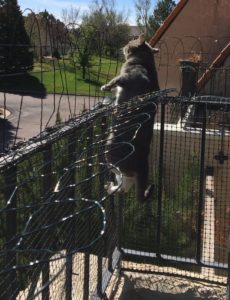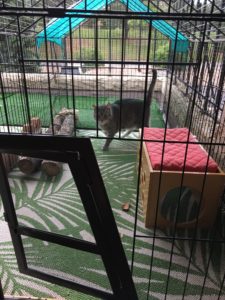The Cat Outdoors…
The cat is a born hunter. In the wild, a cat will spend a large part of its time on the prowl, looking for food. His vision is geared toward surveying the landscape for something moving; his large conical ears and broad frequency range of hearing, help him locate prey and also predators; his sense of smell too plays a role in seeking prey and avoiding predators and danger.
Being outdoors gives your cat opportunity to hone her hunting skills, and in doing this, she will be entertained and allowed to “be a cat” and do “ cat things”. What is a safe place for cats outdoors?
Risks of being an Outdoor Cat
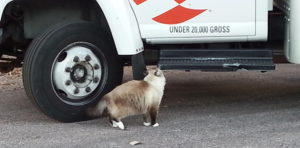
- Injury or death from predators (dogs, wildlife such as coyotes)
- Injury or death from cars on nearby roads
- Contracting illness from neighborhood cats
- Injury due to cat fights
- Infection with parasites due to hunting or exposure to other animals
Benefits to being an Outdoor Cat
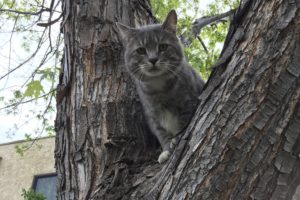
- Fewer behavior problems (urine marking, scratching furniture, aggression toward housemates)
- Opportunities for exercise – reduced risk of obesity
- Opportunities for hunting and exploration – mental stimulation
- Stimulation from a varied environment – e.g. changing weather
The Cat Friendly Home: Safe Places Outdoors
If you have a yard with a high fence, you may already have a purrfect safe outdoor place. If you need to, you can “cat proof” your fence if it is 6 feet high or more. You can install rollers on top of the fence (Oscillot.com) or use a system with overhangs on the fence (Purrfect Fence). Both systems keep your cat from jumping out and can keep neighborhood cats and coyotes out. A fenced-in yard may still need safe places for your cat such as low shrubs or dense foliage to hide in.
Larger screened-in patios called catios give both people and cats a place to relax – once again, cat trees and plantings my be needed to provide safe places for your cat to nap or just get away from things. Don’t forget – you can play with your cat outdoors!
Other options for smaller yards or apartment balconies include cat enclosures, oversized metal dog crates, portable enclosures that can be set up and collapsed when not in use (kittywalk) and cat “window boxes”. Plants, scratchers, and places to hide may be added to these to provide stimulation and safe places.
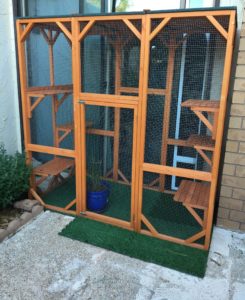
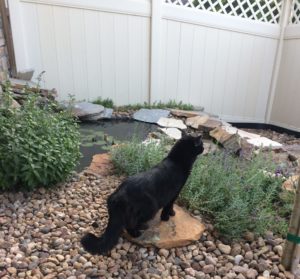
How do Cats Feel about Cat Enclosures?
Cat enclosures may frustrate some cats, particularly those who were previously free-roaming. We are all familiar with becoming annoyed or angry when we are unable to get what we want – from struggling with leveling up in a video game to having difficulty finishing that project at work. If your cat seems frustrated – pacing and trying to break out – encourage some other behaviors to help him cope with frustration.
Providing your cat with ways of coping with the frustration of being restricted to a yard or enclosure.
DO PROVIDE:
- posts/logs to scratch on
- puzzle feeders with snacks
- places to hide and play in
- cat grass to nibble on
- SUPERVISE YOUR CAT AS NEEDED
DON’T:
place bird feeders close to enclosures or window boxes – this could increase frustration as your cat can’t capture the birds. It is like putting ice cream in front of a person on a diet
Jail Break and What Keeps Gus Safe
Gus is a 3 year old neutered male cat who was previously free-roaming. The second floor porch is enclosed with a railing with mesh and wire on it. Neighbor cats have not gotten in; the other 3 cats in the house do not get out. Gus can pull himself up through the wire.
